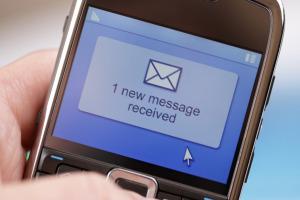OMG! SMS hits 21
 On 3 December 1992, a 22 year old engineer by the name of Neil Papworth used a PC to send the text message “Merry Christmas” via the Vodafone network to the phone of a man called Richard Jarvis. It was the first ever SMS to be sent.
On 3 December 1992, a 22 year old engineer by the name of Neil Papworth used a PC to send the text message “Merry Christmas” via the Vodafone network to the phone of a man called Richard Jarvis. It was the first ever SMS to be sent.
21 years on and SMS has become the second most commonly used feature on a mobile phone (behind checking the time) and a reported 8 trillion messages are sent annually (the equivalent of 250,000 every second). However, the growth of SMS traffic has stagnated in recent years, driven by increased global adoption of smartphones, which has paved the way for alternative forms of mobile communication to evolve. We are now spoiled for choice with access to email, multimedia messaging services (MMS), instant messages and mobile applications, all within a mobile device.
Ipsos has been carrying out SMS surveys for almost 11 years, such as our groundbreaking text poll for BBC Watchdog in 2003 and the Orange Business Jury which sourced timely opinions from a panel of over 970 small business owners, managers and decision makers working for companies with up to 250 employees. The simplistic nature of SMS makes it a perfect fit for surveys that require quick turnaround results and access to opinions and attitudes in close proximity to an event or occasion.
But SMS is now competing against alternative mobile technologies that allow researchers to better engage with participants and gather more detailed information and context. Firstly, there are web based surveys. Many of our surveys now allow participants to carry out online mobile surveys on multiple devices, whether it is a laptop, tablet or mobile phone, meaning a participant can start a survey on one device and continue the same survey on another. The introduction of the smartphone has also allowed researchers to capture much richer, in-the-moment information through mobile apps. Ipsos has developed a number of innovative case studies using a variety of app based research techniques, including geo triggering, mobile diaries and one off surveys, all of which enable participants to feedback using text, photo and video.
Whilst modern techniques have clearly enhanced the way we as an industry can reach out to participants, it should be noted that the evolution of these ‘new’ mobile technologies does not necessarily signal the end for SMS. The technology almost certainly has a part to play as both a form of communication and as a mobile research tool, particularly in developing markets where smartphone penetration is growing but currently remains low. From a research perspective, SMS is likely to find its role become more of a supplementary one. Despite almost half of email now being opened on a mobile device, our experience suggests SMS represents a more effective form of invite for app based surveys. The vast majority of text messages are read within five minutes of being received. SMS also has global reach, due to its compatibility with just about every mobile device on the planet, unlike other tools.
At 21, there is evidence to suggest the SMS is now at the peak of its technological lifecycle, particularly as a form of communication. However, from a research perspective at least, SMS remains an integral part of the mobile toolkit. Happy 21st Birthday, SMS (and Happy Christmas!).
- For more information on our mobile research capabilities, visit www.ipsos-mori.com/mobileresearch



